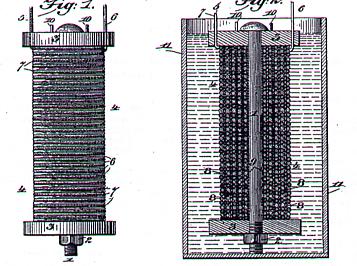
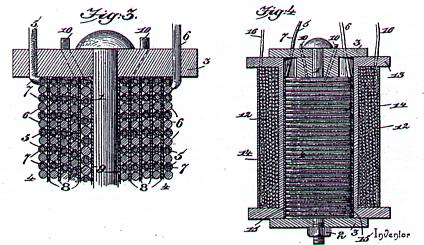
Stubblefield Cell


The Stubblefield Cell
![]()

William D .Snow Patent # 155,209
Improvement in earth batteries for generating electricity.
Z = Zinc C = Carbon
![]()
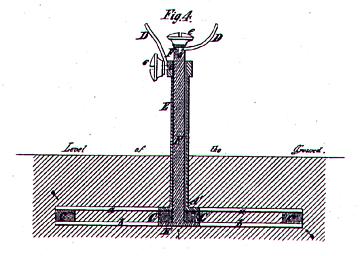

J. Cerpaux. Patent # 182,802
Electric-Piles
![]()
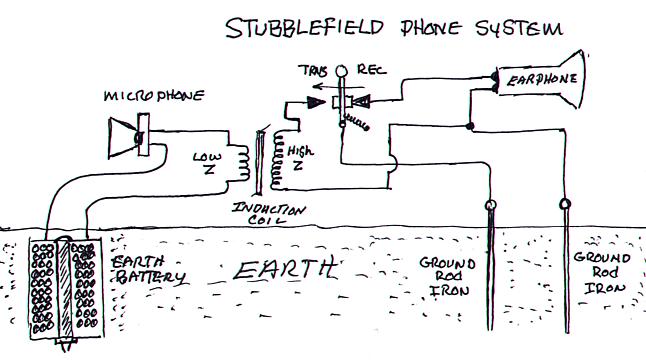
![]()
The transmitter below was used in my experiments. I used switching through a special antenna using large discs 10 inches in diameter insulated from the mast 30 feet above the earth .

We do not know the secret of the earth charge as Nathan Stubblefield determined it. Others since his time have observed fluctuations at certain times of the year in ground energy. It may be that a sudden induction is required before the excess ground charge surges to the surface..... like priming a pump.
So I did some experiments in building different types of cells. I used a 10 inch carriage bolt 3/4 inch diameter between two delron spacers. I used steel wire and copper wire that was coated. I would wind one layer and sand it off, check for shorts, and then wrap it with gauze and start the next winding. I then put the secondary induction coil windings on.
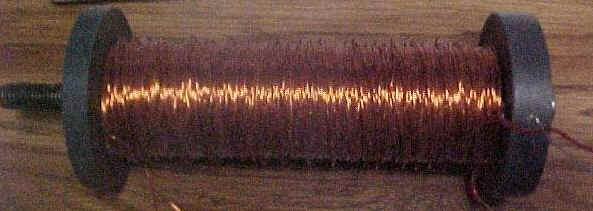
These are the results I got in a one gallon plastic jug filled with water. Volts .07, 250ma into dead short through meter shunt. I'm still working on a better cell to go into the ground at this time.
![]()
Stubblefield published an extraordinary brochure in 1898 to attract investors who had expressed interest in consolidating a small corporation around his work. In this brochure, Stubblefield insisted that power for his device was not generated in the cell. He calmly stated that the cell received its surplus energy from the earth. In a less discussed portion of the brochure, Stubblefield stated that "electrotherapeutic" devices had been developed from his earth battery. Other researchers made similar claims for their earth batteries (Hicks, Mellon). During this time, Stubblefield declared that news, weather, and other announcements could be broadcast through the ground across a great territory for private reception. He also added that simultaneous messages and news of all kinds would soon be transmitted through the ground from a central distribution station. (Shades of Tesla!)
In 1902 Stubblefield set up one of his sets in a "Mainstreet" upper office... in a hardware shop. From that point to his farm (some 6000 feet distant) he conducted continuous conversations with his son Bernard. Tapping with a pencil on his one-piece transceiver, Bernard was quickly heard in a loud, very clear voice. This transceiver was a carbon button placed in a tin snuff box. Speech and response were transacted through the same device, which acted as both microphone and loudspeaker. Cells (EARTH BATTERIES) were placed downstairs from the office in the ground. They were never removed and never wore out, though operating twenty-four hours a day around the clock.
Nathan Stubblefield offered to construct a large scale power station for the town of Murray. His quoted initial installation costs were estimated at five thousand dollars. The town politicians declined the offer. As a result, the technique of drawing up electricity from the earth remains a mystery.
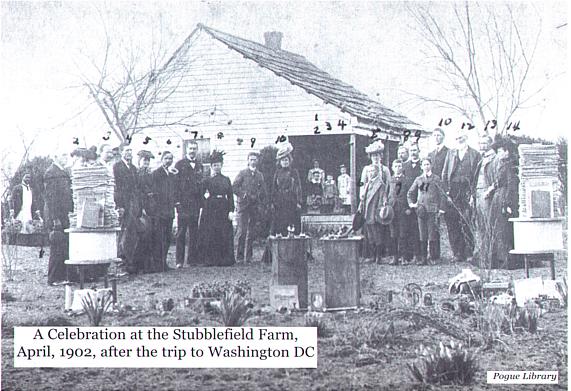
The Stubblefield ground radio system was demonstrated for approximately one thousand Murray residents. Photographs of Stubblefield and his family, and a good crowd of witnesses from town, show the cell laying on the ground among all his assembled inventions; and a flower-pot sized coil of good volume. Other devices show motors and large capacitor stacks for aerial voice transmission experiments.
Stubblefield declares it to be an "energy receiver....a receptive cell for intercepting electrical ground waves". Its conductive ability somehow absorbs and directs the enormous volumes of earth energy.
Whether the current derived from this cell is electricity as we know it has been questioned. One indicator is not found when considering his use of the energy in lighting lamps. With this energy Nathan Stubblefield operated a score of arc lamps at full brightness for twenty-four hours a day. There was a definite trigger by which this energy was stimulated and maintained.
The induction coil which bears his name is equipped with three coils which are wrapped around and upon a heavy iron core. Bare iron wire and cotton-covered copper wire are wrapped side by side, comprising a primary coil body. Each layer of the primary coil body is covered by a band of cotton insulation, bringing four wire leads to the coil terminus. Two leads of iron and two of copper are external to the coil. Commercial electrical power is obtained through these connective terminals.
In addition to this bimetallic winding, there is a third winding: the "secondary". This third coil is insulated from the primary bimetallic coil, serving as a trigger device. Presumably, a stimulating impulse shock was introduced into the tertiary coil, after which the upwelling electrical ground response brought forth powerful currents in both iron and copper coils.
Electrolytically (as a battery in acid or saltwater) the Stubblefield coil is disappointing, producing less then one volt according to those who have duplicated its construction. Stubblefield's bimetallic coil was a "plug": a receiver which intercepts the vast and free electrical reservoir of the ground itself. His patent and subsequent company brochures define the manner in which his earth battery was to be activated.
Technically, the Stubblefield device is a modified thermocouple (a bimetal in tight surface contact) but a thermocouple could not supply the degree of power which he reported. While this arrangement could develop a few milliwatts of power in appropriately hot ground spots, the thermoelectric explanation of the device cannot explain the phenomenal output reported in the news reports of Stubblefield's demonstrations.
Furthermore, though the Stubblefield power receiver is wound like an induction coil, it produces a steady direct current output. This poses additional problems for the conventional engineer. Electrical induction only occurs with electrical alternations, oscillations, and impulses.

Nathan and Bernard Stubblefield, with wireless telephone
January 1, 1902
Witnesses describe ground-powered motors which ran unceasingly and unattended for months without need for replacing or replenishing the ground battery. Small machinery, clocks, and loud gongs were run by other ground-buried cells as reported by credible witnesses. Stubblefield may have discovered the auto-magnifying voltage effect of electrostatic induction in coils before Tesla, who later utilized the effect in his special electrostatic Transformers.

Is this the first induction pulse motor?
These buried coils may have become saturated with earth electrostatic energy, which travelled from subterranean depths. In such a case, the mere battery power of the coil was replaced by the electrostatic flow, the coil acting as an electrode. This seems obvious when considering the fact that its ordinary battery current (1 watt) was gradually replaced by continually growing electrical current of far greater proportion.
![]()
Observations made at Pittsburgh, Pa.,
communicated by E.W. CULGAN,
Telegraph manager.
During Aug. 28th the intensity of the current evolved from it varied very much,
being at times no stronger than an ordinary battery, and then suddenly changing the poles
of the magnets it would sweep through them, charging them to their utmost capacity, and
compelling a cessation of work while it continued.
On the morning of Sept. 2d, at my request the Philadelphia
operator detached his battery, mine being already off. We then worked with each other at
intervals as long as the auroral current continued, which varied from thirty to ninety
seconds. During these working intervals we exchanged messages
with much satisfaction, and we worked more steadily when the
batteries were off than when they were attached.
On the night of Aug. 28th the batteries were attached, and on breaking the circuit there
were seen not only sparks (that do not appear in the normal condition of a working line) but at intervals regular streams of fire, which, had they been permitted to last more than an instant, would
certainly have fused the platinum points of the key, and the helices became so hot that
the hand could not be kept on them. These effects could not
have produced by the batteries.“
In 1876, the American Alexander Graham Bell succeeded in
developing a practical telephone. The first telephones functioned so that a telephone
receiver was installed at both ends of a wire. The earth functioned as the return wire.
Batteries were not necessary because the telephone receiver's permanent magnet produced an
electrical current in the coil when a magnetically conductive membrane was activated by
speech. Finland's first telephone connection was built during December of 1877 in
Helsinki.
